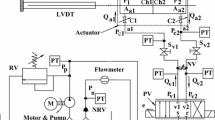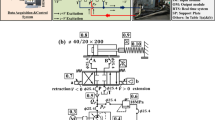Abstract
The physical model of an electrohydraulic actuation system has been obtained. To arrive at the closure of the model, experimental models for actuator friction and the characteristics of the proportional valves have been constructed. The variation of discharge through the proportional valve has shown the metered ports to be nonmatched that has been taken care of by estimating two separate coefficients for the main flow path and one leakage coefficient. An algebraic friction model retaining all the features of the existing differential model has been developed. All these nonlinear subsystem models have been integrated together in MATLAB/SIMULINK frame to predict the actuation dynamics. The variations of the predicted and experimental displacements of the piston against different command signals have been found to be quite close to each other.
















Similar content being viewed by others
References
Blackburn JF, Reethrop G, Shearer JL (1960) Fluid power control. The M.I.T Press, Cambridge
Merritt HE (1967) Hydraulic Control Systems. Wiley, New York
Kaddissi C, Kenn’e JP, Saad M (2000) Identification and real-time control of an electrohydraulic servo system based on nonlinear backstepping. IEEE/ASME Trans Mech. 12:12–22
Janocha H, Pesotski D, Kuhnen K (2008) FPGA-based compensator of hysteretic actuator nonlinearities for highly dynamic applications. IEEE/ASME Trans Mech. 13:112–116
Lee SY, Blackburn JF (1952) Contributions to hydraulic control; 1-steady-state axial forces on control valve pistons. Trans ASME 74(6):1005–1011
Wu D, Burton R, Schoenau G (2002) An empirical discharge coefficient model for orifice flow. Int J Fluid Power 3(3):13–19
Mookherjee S, Acharyya S, Majumdar K, Sanyal D (2001) Static-performance based computer-aided design of a DDV and its sensitivity analysis. Int J Fluid Power 2:47–63
Zhang H, Nikiforuk PN, Ukrainetz PR (1993) Neural adaptive control of MIMO electrohydraulic servosystem. In: Proc. 3rd Int Conf Fluid Power Transmission Contr., Hangzhou, pp 315–320
Anyi H, Yiming R, Zhongfu Z, Jianjun H (1997) Identification and adaptive control for electro-hydraulic servo system using neural networks. IntConf Intelligent Processing Syst, Beijing, pp 688–692
Karnopp D (1985) Computer simulation of stick-slip friction in mechanical dynamic systems. Trans ASME J Dyn Syst Meas Contr. 107(1):100–103
de Wit CC, Olsson H, Astrom KJ, Lischinksy P (1995) A new model for control of systems with friction. IEEE Trans Autom Control 40(3):419–425
Owen WS, Croft EA (2003) The reduction of stick-slip friction in hydraulic actuators. IEEE/ASME Trans Mech. 8(3):362–371
Khayati K, Bigras P, Dessaint L-A (2009) LuGre model-based friction compensation pneumatic actuator using multi-objective LMI optimization. Mechatronics 19(4):535–547
ShaD Bajic V, Band Yang H (2002) New model and sliding mode control of hydraulic elevator velocity tracking system. Simul Pract Theory. 9(6):365–385
Yanada H, Sekikawa Y (2008) Modeling of dynamic behaviors of friction. Mechatronics 18(7):330–339
RE 29 061/09.3900 Catalogue reference of PV
Lippmann R (1987) An introduction to computing with neural nets. IEEE Acoust Speech Signal Process Mag. 4(2):4–22
Rumelhart DE, Hinton G, Williams R (1986) Learning internal representations by backpropagating errors. In: Rumelhart DE, McClelland JL (eds) Parallel distributed processing: explorations in the microstructure of cognition, foundations, vol 1. MIT Press, Cambridge, pp 318–362
Cybenko G (1989) Approximation by superpositions of a sigmoidal function. Math Control Signals Syst 2(4):303–314
MatlabSimMechanics documentation on joint stiction actuator (2004) Matlab 7.0.0.19920 (R14). The Mathworks, Inc.
Das J, Das K C, Saha R, Mookherjee S, Sanyal D (2008) Modeling and simulation of an electrohydraulic actuation system through subsystem characterization. In: Proc. INDICON 2008 IEEE conf exhibition control communications automation. IIT Kanpur, India, II, pp 514–520
Marton L (2008) On analysis of limit cycles in positioning systems near Stribeck velocities. Mechatronics 18(1):46–52
Sarkar BK, Das J, Saha R, Mookherjee S, Sanyal D (2013) Approaching servoclass tracking performance by a proportional valve-controlled system. IEEE/ASME Trans Mechatron 18(4):1425–1430
Acknowledgments
This work has been supported by AR&DB New Delhi and SAP-DRS of UGC New Delhi and Jadavpur University for equipment and Prof. Dipankar Sanyal, Dr. Saikat Mookherjee, and Dr. Rana Saha of Mechanical Engineering Department, Jadavpur University, Kolkata, for help and valuable suggestions.
Author information
Authors and Affiliations
Corresponding author
Additional information
Technical Editor: Jose A. dos Reis Parise.
Rights and permissions
About this article
Cite this article
Das, J., Mishra, S.K., Saha, R. et al. Nonlinear modeling and PID control through experimental characterization for an electrohydraulic actuation system: system characterization with validation. J Braz. Soc. Mech. Sci. Eng. 39, 1177–1187 (2017). https://doi.org/10.1007/s40430-016-0634-3
Received:
Accepted:
Published:
Issue Date:
DOI: https://doi.org/10.1007/s40430-016-0634-3




